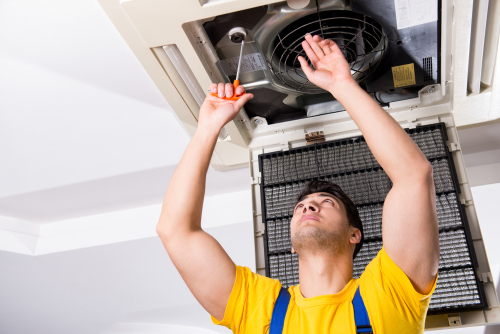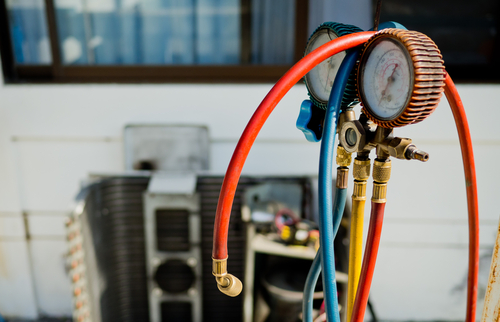
HVAC and Ventilation System Upgrades For COVID Mitigation
More and more commercial buildings are starting to open up again as COVID-19 restrictions begin to loosen across the country. However, these same buildings also need to prove to employees and customers alike that they are as safe as possible. PPE, mask mandates, and sanitation are a significant part of this, but something else that should be covered in this regard are ventilation systems. The CDC has noted that appropriate air ventilation is a crucial way to minimize the potential spread of COVID-19 in indoor spaces.
This puts a lot of your clients in a bind. Legacy/outdated systems may not provide the appropriate ventilation to meet a lot of these benchmarks. With this in mind, here are some of the things your clients may be asking about their air ventilation systems and some of the other popular HVAC upgrades.

Table of Contents
Your Air Ventilation System and COVID-19
First, let’s briefly cover the role that a proper ventilation system plays in lowering COVID-19 transmission risk. By nature, HVAC systems filter the air in a space as it is circulated. From what we know about COVID-19, the primary mode of transmission is droplets expelled when we cough, sneeze or talk. There’s a debate about how transmissible it is via air, but because there is a possibility this is the case, indoor buildings must have a plan to address this.
You can use natural ventilation in some spaces to help with this, like opening up the windows. However, a proper HVAC system helps filter out any airborne contaminants, viruses included. For clarity, even the best air ventilation system isn’t a substitute for other protection measures. Instead, by complementing the other best practices you take, this adds another layer of protection for your team and your customers. You can also get more use out of your existing system by opening the outside air intake if available.

Potential Upgrades Your Clients May Be Looking At
To be clear, if your clients are asking for an air filtration “silver bullet” to completely avoid the risk of transmission, that doesn’t exist. Instead, there are a lot of the upgrades available just allow these air ventilation systems to do their job more effectively and efficiently. For buildings like public schools with systems that are decades old, this can make a huge difference. Here are some of the prime examples to consider.
Configuring your settings
In some cases, you don’t necessarily need to replace your system outright as much as you need to change procedures. There are a few ways you can go about this. Adjusting settings to run without interruption is a good idea rather than shutting down overnight. It may also make sense to increase the exchange with fresh air outside to minimize recirculation.
Airflow control
Many old air ventilation systems/HVAC solutions are reliant on fixed-speed motors. Another possible upgrade option is using a variable speed motor. This allows for better control of airflow, including a minimum setting. Some may want to take this to the next level, implementing a whole airflow control system. These make it easier to adjust airflow to factors like pressure.
Air purification systems
You have a few options on hand to get better air purification. Filtration is the most common one, but you can also look into things like thermal sterilization or irradiation. These inactivate the particles without removing them from the air.

New filters
In some cases, if you have a relatively more contemporary system, you may be able to get away with just getting new filters that trap more particles. However, don’t just buy the best one that you see. Not every filter is compatible with every system.
Energy efficiency
Looking for a more energy-efficient air ventilation system is more helpful in a roundabout way. Many building owners would typically avoid having their systems run at max power for an extended period in order to avoid excessive energy costs. However, now, doing that for at least peak work hours is probably the best way to ensure you get maximum ventilation and protection. Energy-efficient systems are a great way to manage this issue without necessarily breaking the bank.
Conclusion
As a final note, when you are talking to your clients about some of these upgrades or other purchases, it’s important to make sure that you don’t forget the basics as well. Even the best HVAC systems eventually need upkeep, so make sure to put together a maintenance plan with your clients after upgrading so they can have a proper service schedule. It may also be worth it to alert your clients of some of the basic signs that their air ventilation system may be faltering or need additional service. In many cases, people go along unaware until it stops working completely. However, when we talk about the risk of COVID-19 transmission, you must stay ahead of the issue.

The potential relationship between ventilation systems and COVID means that a lot of your clients/prospective clients may be mulling over HVAC upgrades. This is especially the case for commercial spaces, where there’s both a greater risk of transference and legacy systems. As a result, your company should be preparing to offer a greater amount of ventilation system upgrades and be knowledgeable about what we know about COVID and air quality.
Making sure that everyone is working off the same playbook in terms of this information requires advanced project management software like eSUB. We offer cloud storage solutions that allow you to share the same pieces of information with your field and office teams. In addition, there’s always going to be a concern about the ROI with any new services you offer. Our financial tools allow you to compare bids and actuals to ensure that the new ventilation system services you offer remain profitable.
